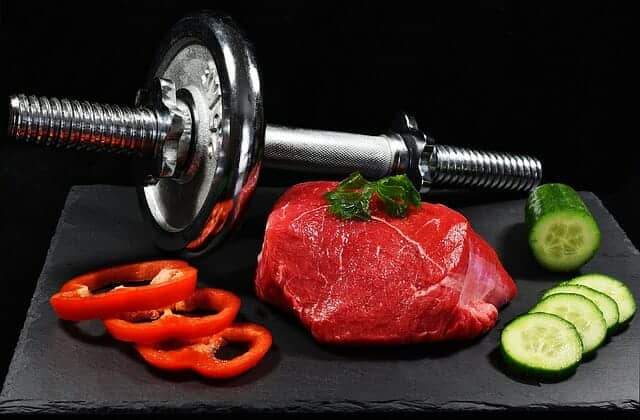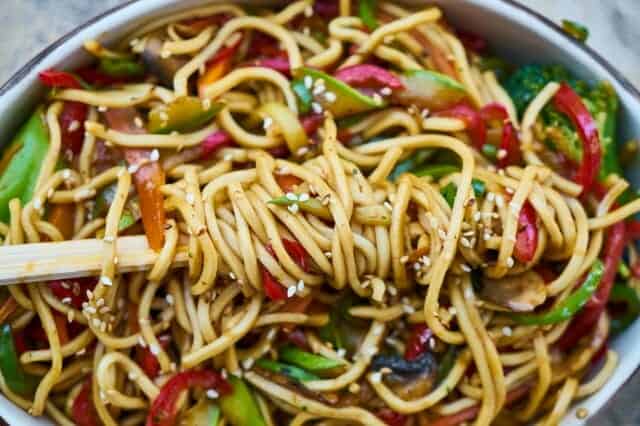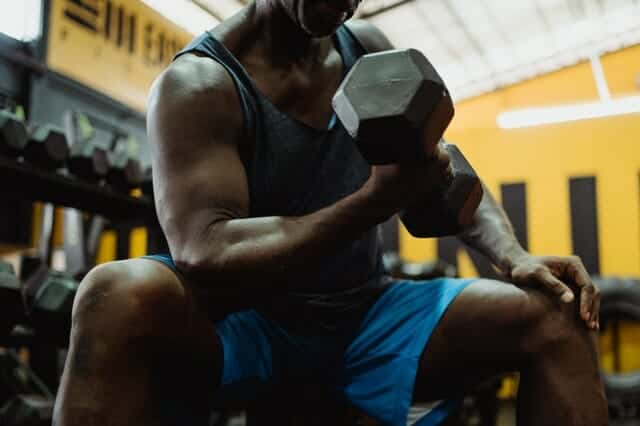What to eat for mass? Despite appearances, composing a menu that will activate muscle tissue for dynamic growth is an easy task. All you need to do is follow some simple rules and take care of the right supply of nutrients essential for muscles in your daily menu. The calorie content of meals is also very important. While a reduction diet involves creating a negative calorie balance, a mass gain diet requires a positive one.
How to compose meals that accelerate muscle building, but at the same time do not result in fat gain? How to choose protein and other nutrients? How do you eat to have the strength and energy needed to complete strenuous workouts? How to eat so that your muscles get the optimal amount of building material? Read the article and find the answers!
Table of contents
- 1 How to increase muscle mass – a three component plan of action
- 2 What to eat for mass? Basic principles of a diet for muscle mass
- 3 How many calories should you eat to gain mass?
- 4 Protein in a diet for mass. How much protein per kg of body mass should we consume?
- 5 Carbohydrates in a diet for mass
- 6 Fats in a diet for mass
- 7 What to eat for mass? Meals and a menu
How to increase muscle mass – a three component plan of action
Several key elements contribute to activating the process of building muscle mass:
- proper nutrition of the whole body,
- systematic muscle exercise,
- stimulating muscle tissue to faster growth by supplying amino acids needed by muscles,
- Stimulating metabolic processes to activate anabolism and inhibit catabolism,
- supporting hormone management (by eating products that increase the production of growth hormone and testosterone by the body).
The realization of all these elements will be possible due to an adequate combination of a mass gaining diet with mass exercises and supplementation. Strength training will cause the muscle fibres exposed to increased work to start building up. At the same time thanks to a special mass gaining diet our body will receive a large dose of energy fuel, as well as building materials necessary for the synthesis of muscle proteins.
And mass supplements will support us in body shaping in several ways:
- add energy,
- multiply the rate of increase in lean body mass,
- accelerate muscle and whole body regeneration,
- improve concentration,
- increase motivation to exercise,
- improve physical fitness,
- Improve workout efficiency,
- supplement deficiencies of important nutrients.
Some mass gainers, however, do not take all these elements into account in their body building plan, e.g. they are selective with regard to dietary recommendations, skip workouts, do not use any nutrients, vitamin complexes, creatine stacks or mass boosters, which results in either slow or unsustainable effects.
If you want to conduct a muscle mass cycle efficiently and achieve noticeable muscle growth at the very first stage, follow this triple action plan combining diet, training and supplements, and the positive results will surely surprise you. Let’s start by establishing a nutrition program.
A rich, effective, fast-acting mass gainer: Nutrigo Lab Mass

What to eat for mass? Basic principles of a diet for muscle mass
The way we eat determines literally everything – our appearance, the way our organs work, the level of immunity, our mood, mental and physical condition, susceptibility to diseases. Also the composition of the body (more fatty or more muscular figure) is influenced by the type and amount of food we eat. The second factor is obviously the degree of physical activity.
In order to increase the level of muscle tissue, while maintaining a low level of fat tissue, we need to consume more calories per day than our energy needs, but these calorie surpluses should come mainly from proteins, not fats or carbohydrates.
In connection with the need to increase the supply of calories, we can say that the diet to gain weight is also a diet to gain weight. Of course, it is about gaining muscle, not fat. In order to activate the increased muscle tissue growth, we should concentrate on consuming food rich in protein.
It is best to opt for a variety and use multiple sources of protein, both plant and animal. If you are a vegan, your task is somewhat more difficult. We don’t have a whole range of protein products which are very useful in building mass (e.g. dairy products, fish). On the other hand, we have a wide range of legumes rich in well-absorbable protein, as well as other sources of plant protein such as tofu or seeds.
To sum up, a diet for muscle mass should be based mainly on protein, which is a nutrient and building material for our muscles and which plays a key role in the process of building mass. The menu also includes large portions of products containing lots of vitamins and minerals, as well as adequate amounts of complex and simple carbohydrates and healthy fats rich in omega 3 acids.
In order to maintain the electrolyte balance in the body and avoid dehydration, regular water replenishment should also be a priority (approx. 2-3 litres of water per day is recommended for a mass gainer diet, but some people need more, especially on training days).
We already know what our menu should be based on, it is also worth telling us which foods to avoid. We avoid mainly fatty meats, heavy, floury dishes as well as highly processed food, including ready meals, fast food, sweets, crisps and similar salty snacks.
A well-balanced diet rich in all important nutrients will ensure proper muscle function, make the body recover better after exercise, give you energy and have a positive effect on your training capacity.
How many calories should you eat to gain mass?
Lack of effects in the form of a regular increase in muscle volume is usually a consequence of insufficient calorie intake and improper meal composition. When we take in too small portions of food and eat too infrequently (e.g. only 2-3 times a day), our body allocates nutrients to its current needs and quickly uses up all the energy we provide it. Due to the lack of sufficient building material it is not able to build new muscle fibres.
How many calories to consume during weight gain? There is no single answer, because each of us has a different body, leads a different lifestyle and burns a different amount of calories during normal functioning. However, we can easily determine the optimal amount of calories needed when making mass.
First we need to determine our individual caloric needs. Special tables and calorie demand calculators available on many websites will allow us to calculate it precisely. Once you know this value, add 20% to it, and you will get the number of calories that will allow you to start the process of muscle growth.
For example, if our calorific needs are 2500 kcal, we add 20%, i.e. 500 kcal and we obtain the result of 3000 kcal. And this is how much we should provide during a mass gaining cycle.
If you notice that you gain weight too slowly, you can slightly increase this value (for example by 150 kcal). However if with this amount of calories consumed fat tissue grows at the expense of muscle tissue, it means that we choose wrong products and compose meals incorrectly (probably we consume too little lean protein, and too many carbohydrates or lipids, or both). It could also be the result of too little physical activity (e.g., irregular, too infrequent, or too low-intensity workouts).
Check: Ranking of testosterone boosters
Protein in a diet for mass. How much protein per kg of body mass should we consume?

Protein is what our muscles are madeof , so the intake of this nutrient for people on a mass diet should be higher than in normal conditions. Typically, trainers and nutritionists recommend providing about 2 g – 2.5 g of protein for each kilogram of body weight.
For example, if you weigh 80 kg and want to dynamically gain muscle mass, you should consume about 160 – 200 g of protein per day.
Greater amounts than 2.5 g of protein per 1 kg of body weight are not recommended. Remember that protein in excess is not good for your body. It may disrupt the calcium balance in the system, interfere with digestion and metabolism, adversely affect liver function, disrupt the acid-base balance and overload the kidneys.
The best sources of protein
These are the products containing a large amount of protein. When composing meals for mass, it is worth using them as often as possible. Since there are many of them, they are versatile in application and can be prepared in hundreds of ways, we will certainly avoid culinary monotony.
The best sources of animal protein:
- fish (e.g. tuna, halibut, cod, hake, salmon, pollock),
- meat (chicken breast, turkey breast, skinless turkey thigh, skinless duck breast, pork tenderloin, lean loin, beef tenderloin),
- seafood,
- cottage cheese,
- natural yogurt,
- eggs,
- whey,
- kefir,
- buttermilk,
- milk,
- yellow cheese,
- cottage cheese,
- blue cheese,
- Greek yogurt.
Best sources of plant protein:
- Beans,
- soybeans,
- peas,
- lentils,
- chickpeas,
- broad beans,
- green peas,
- green beans,
- quinoa (quinoa),
- amaranth,
- tofu,
- tempeh,
- seitan,
- seeds chia,
- sunflower seeds,
- hemp seeds,
- pumpkin seeds,
- flaxseed,
- nuts,
- almonds,
- algae (e.g. chlorella and spirulina),
- rice,
- buckwheat groats,
- oatmeal,
- spelt,
- avocado,
- bananas.
Carbohydrates in a diet for mass

Carbohydrates are one of the key nutrients. Being the primary source of energy for the body, it is responsible for its proper functioning. This applies to all organs and tissues, including muscles.
The role of carbohydrates in the diet of people training for mass is very important. However to ensure that carbohydrates benefit our physical performance, well being and give our muscles fuel and help build muscle mass, and don’t turn into fat tissue, they must be provided in the right amounts. No less important is the type of carbohydrates we consume and the time of their consumption (during workout hours we focus on other types of carbohydrates, and on others during breakfast and dinner).
How many carbohydrates to consume during a weight training cycle? For every person who trains hard, including those who want to build muscle mass, the recommended amount of carbohydrates is 5-7g for each kilogram of body weight.
For example: a person weighing 80 kg should eat 400g – 560g of carbohydrates per day.
When it comes to the types of carbohydrates, it is certainly worth avoiding those considered the worst, namely: sweets, sugary coloured drinks, fast food, crisps, white, highly processed bread. However, there is a whole range of healthy foods rich in carbohydrates and they should be present in our daily diet.
The best sources of carbohydrates
- fruit,
- vegetables,
- legumes,
- natural honey,
- bran and cereal,
- groats,
- rice (white, wild, brown, parabolic, basmati),
- pasta,
- good quality bread, especially wholemeal, wholemeal and rye bread,
- grains,
- quinoa,
- amaranth.
Simple carbohydrates (such as fruit, white pasta and white rice) are especially recommended during the post-workout meal. This will allow us to replenish muscle glycogen, which was used up during intensive exercise and will improve the process of muscle protein synthesis. Also just before the workout a portion of simple carbohydrates is recommended.
In the remaining meals of the day it’s worth giving priority to complex carbohydrates (present in wholemeal bread, brown rice, coarse groats, oatmeal, wholemeal pasta, seeds).
Fats in a diet for mass
When creating meals for mass, do not forget about certain amounts of fat, which is also a necessary nutrient for the proper functioning of the body. It is necessary for the dissolution and absorption of certain vitamins, protects our cells from damage, ensures the proper functioning of the nervous system, acts as a reserve source of energy, and accelerates muscle regeneration.
The recommended amount of fats for strength trainers is about 1 g per each kilogram of body weight. Remember to reach for mainly healthy types of fats such as: olive oil, vegetable oils, nuts and grains, Greek yogurt, cream, fatty cheeses, peanut butter, coconut oil, fatty fish.
But we should avoid the bad, adversely affecting the health and figure varieties of fats, such as fatty meats and cured meats, lard, hard margarine, chips, French fries, fast food, cakes and bars, cakes and cakes. When it comes to butter, yes, we can sometimes reach for it, but in small quantities, mainly as an addition, not one of the main components of the menu.
During an intensive training cycle the body burns large amounts of calories, so if we want to build mass we must provide it with adequate amounts of fuel and muscle building material on a regular basis. To achieve this it is worth eating more than 3 basic meals a day. Ideally 5 or 6.
Breakfast for mass should be extremely rich and varied. It should not lack wholesome protein (eggs, cheese, lean meats) and complex carbohydrates (wholemeal bread, cereals, vegetables).
It is also important to have a gooddinner that is filling, nutritious and contains all the important nutrients (protein, carbohydrates, fats, vitamins and minerals).
Dinner for weight gain should consist mainly of protein (e.g. cottage cheese, blue cheese, lean meat, fish) and less of complex carbohydrates. It is also worth taking care of additional supplements in the form of vegetables or fruit. In addition to these 3 main meals every day you should also reach for a healthy second breakfast and afternoon snack. They will give us energy and help to survive until the next big meal.
Day 1
- Breakfast: oatmeal (about 8 tablespoons of oatmeal, 300 ml of milk, a tablespoon of honey), 100 g. cottage cheese, banana
- 2 breakfast: 3 slices of wholemeal bread, tin of tuna in own sauce, salad with cherry tomatoes, cucumber, green olives and sunflower seeds, lemon juice and oil
- Dinner: 100 g rice, 200 g grilled chicken breast, salad
- Tea time: 3 eggs omelette with feta cheese and spinach, fruit
- Dinner: 3 slices of wholemeal bread, approx. 150 g paste of cottage cheese and sprats in tomato sauce, salad
Day 2
- Breakfast: 4 slices of wholemeal bread with butter, blue cheese, Parma ham, olives and tomatoes, smoothie made from kefir and strawberries
- 2 breakfast: oatmeal with Greek yoghurt, avocado, banana, raspberries and nuts
- Lunch: a casserole made of wholemeal tube pasta, yellow cheese, broccoli, peppers, mushrooms, canned tomatoes and fried chicken minced meat with onion (plus spices: herbs de Provence, herbal pepper, cayenne pepper, garlic)
- Snack: Salmon salad
- Dinner: wholemeal toast, fried eggs on ham, lettuce, cucumber, chives
Check: Ranking of supplements for mass


